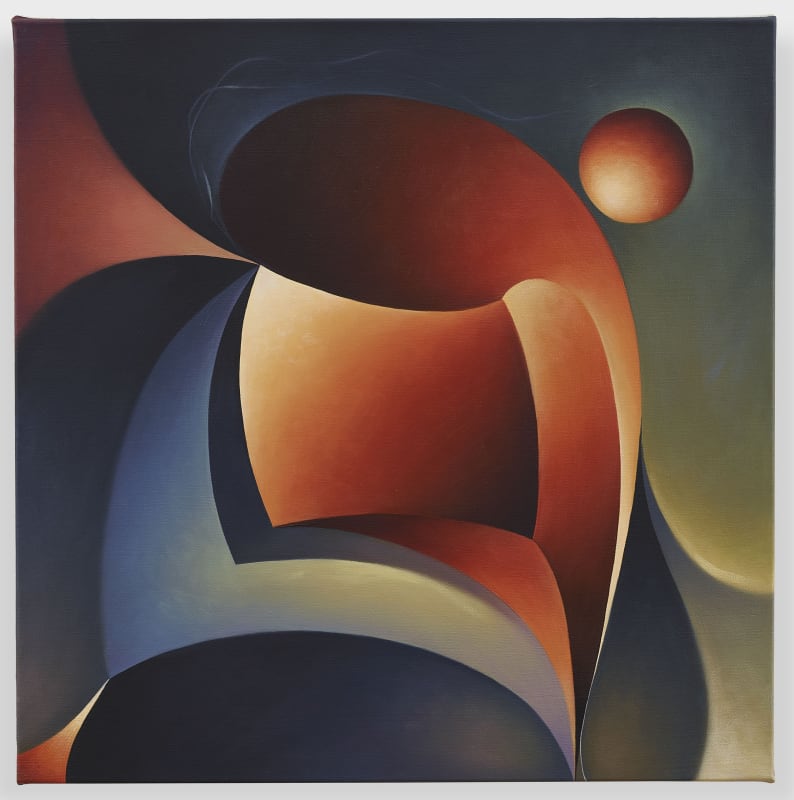Contained biospheres of land, sea, and outer space make up the paintings in Low Speed Highs, Angela Heisch’s current show at Pippy Houldsworth Gallery in London. The works represent a break away from the tradition of landscape painting, wherein Jung’s dueling archetypes of anima and animus seem to be contained, as well. These pieces picture an optical balance of interlocking gradient shapes rendered in an architectural vernacular that recalls Zaha Hadid’s physical structures. Heisch cannily alludes to that optical balance, and even the concept of the gaze itself, through a series of orbs, which can be seen dallying across her canvases, a mnemonic device that is part of her own visual language. The exhibition ashas a whole could be considered a prismatic study of that other mnemonic device, ROYGBIV, coupled with atmospheric harmony, and movement.
The grand opus of the show is Rolled Up Hills (2022), an oil painting on linen in three parts where earthly colors never looked so imperialistic. In shades of burnt sienna, vermillion, and moss, it bursts with the whimsy of Frank Stella’s elongated arches and Grant Wood’s topographical contours. A small black dot hovers in the distance—a shadowed moon, perhaps; an implied horizon, almost definitely. Four other glimmering orbs volley across the panels of the painting, orchestrating an observer’s passage through the work without imposing a locus of origin.
In marked contrast, there is a decisive point of entry into Pearly (2023). The familiar sphere appears as the pupil to a darkened iris, hovering within curvatures of effervescent abalone hues that also mimic a shell. These same undulations could also reference the break in an ocean wave, caught just before the crest tumbles to the surf. This sort of momentary breach between two elements is a root of Heisch’s work. She has said that delayed visual registration amid time and thought in the ephemeral moment where the senses are lost in a haze is a curiosity that she has sought to allegorize.
These moments feel like whispers. While at times one might focus on the optics of trickery, an emboldened trompe-l’œil of shape and color, a gentler hand is also at play. Within the closest of details of this body of work, faint, sinuous lines fall from the breaks in color, withering off the surface plane. Though often lost to the photographic lens, these gestural marks become magnified when standing before them, as in Blue Wind (2023), a wink to the composition of a gale. The work is flushed with amorphous cobalt plumes and shapes; however, negative space seems to be the primary thesis. Its sphere glows from scarlet to cider, mirroring the background pallet. The titular subject of the wind is the vortex, locking the viewer’s gaze into an exploratory state.
These shifting illusive realms could not be achieved had there been any shortness of intentionality in Heisch’s creation. The sharpness of her lines enables a sort of comfort, or reliability, while the dueling, colored forms manipulate a sense of reality, promoting the eye’s desire to absorb them. However, the singular drawing on view, Big Depths (2023), illustrates how this coded visional language might yield the inverse result. While it carries the same balance of density and lightness as the paintings, the chromatic figuration is far more instructive and narrative. Most of the drawing is black and grey in scale, with a withering of bends and bows that faintly resemble a human form. The only exceptions are the small galactic bursts of fiery bronze cast by two radiant orbs, rendered in shades of orange with soft pastel.
The work is one of two pieces in the exhibition that directly reference a celestial expanse. The other one, Alone in Space (2023), features a planetary ball. There is a particular density to this element, as though it holds an immovable weight. Undulating indigo and umber crescents enshrine the sphere, two parts of the composition that do not quite make up a whole. It is in instances like this where the many dualities of Heisch’s work seem to point back to how the gaze engages with the mind. The spaces rendered amplify the differences between familiarity and mystery in the presence of want. Caught between square and rectangular planes, there is movement. These works possess a reflection of what is known, not what is true.

